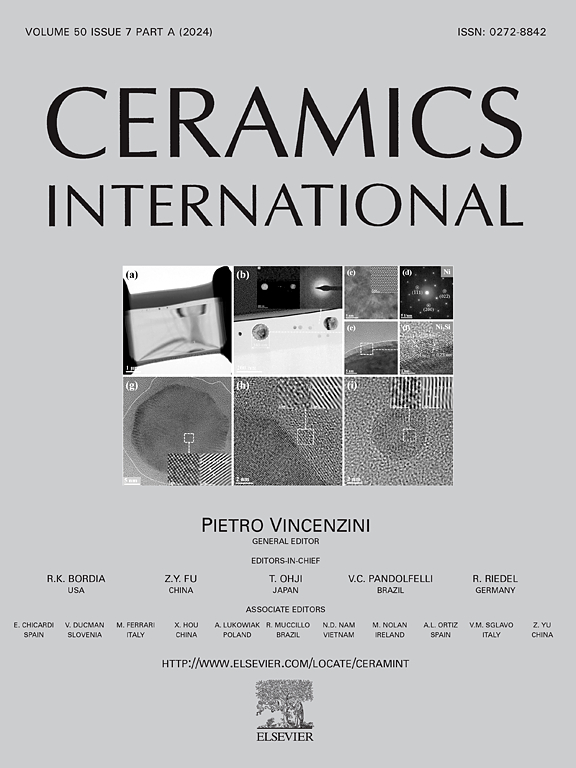Synthesis of near net-shape carbon aerogel composites for high-temperature thermal insulators with complex structures
IF 5.6
2区 材料科学
Q1 MATERIALS SCIENCE, CERAMICS
引用次数: 0
Abstract
The evolving aircraft technology has spurred an urgent need for carbon aerogel thermal insulation composites with intricate structures, which require good near net-shape forming capability and excellent mechanical and thermal insulation properties. However, large shrinkage and thermal conductivity often undermine these properties. Herein, the near net-shape carbon aerogel composite with complex structure was prepared by using pre-carbonized phenolic fibers as reinforcement and chitosan-added carbon aerogels as matrix. Thanks to the polymerization and hydrogen bonding between chitosan and resorcinol-formaldehyde oligomers, the strength of the gel network is enhanced and the shrinkage is reduced, which in turn effectively alleviates the shrinkage stress of the composite, resulting in a composite with an intact structure. In addition, due to the zero shrinkage and low intrinsic thermal conductivity of the pre-carbonized phenolic fiber and the typical mesoporous structure of the chitosan-added carbon aerogel, the composite (0.337 g/cm3) has a low pyrolysis shrinkage (as low as 7.47 %), low thermal conductivity (0.241 W/m·K at 1200 °C), and high compressive strength (17.75 MPa). Notably, compared to the composite prepared by the co-shrinkage strategy with similar density and thermal conductivity, our composite demonstrates significantly reduced pyrolysis shrinkages of 97.95 % and 72.14 % in the X-Y and Z directions, respectively. This study presents a groundbreaking method for producing carbon aerogel composites that excel in near net-shape forming and thermomechanical properties, advancing the development of high-performance complex thermal insulation components for diverse applications.
复杂结构高温绝缘体用近净形碳气凝胶复合材料的合成
随着飞机技术的不断发展,对结构复杂的碳气凝胶隔热复合材料的需求日益迫切,这种材料需要良好的近净成形能力和优异的机械性能和隔热性能。然而,大的收缩率和热导率往往会破坏这些性能。本文以预碳化酚醛纤维为增强材料,壳聚糖添加碳气凝胶为基体,制备了结构复杂的近净形碳气凝胶复合材料。由于壳聚糖与间苯二酚-甲醛低聚物之间的聚合和氢键作用,增强了凝胶网络的强度,减少了收缩,从而有效地缓解了复合材料的收缩应力,从而使复合材料具有完整的结构。此外,由于预碳化酚醛纤维的零收缩率和低固有热导率,以及壳聚糖加碳气凝胶的典型介孔结构,复合材料(0.337 g/cm3)具有低热解收缩率(低至7.47%)、低热导率(1200℃时0.241 W/m·K)和高抗压强度(17.75 MPa)。值得注意的是,与具有相似密度和导热系数的共缩策略制备的复合材料相比,我们的复合材料在X-Y和Z方向上的热解收缩率分别降低了97.95%和72.14%。这项研究提出了一种突破性的方法来生产碳气凝胶复合材料,这种复合材料在近净形状成形和热机械性能方面表现优异,推动了高性能复杂隔热部件的发展,适用于各种应用。
本文章由计算机程序翻译,如有差异,请以英文原文为准。
求助全文
约1分钟内获得全文
求助全文
来源期刊

Ceramics International
工程技术-材料科学:硅酸盐
CiteScore
9.40
自引率
15.40%
发文量
4558
审稿时长
25 days
期刊介绍:
Ceramics International covers the science of advanced ceramic materials. The journal encourages contributions that demonstrate how an understanding of the basic chemical and physical phenomena may direct materials design and stimulate ideas for new or improved processing techniques, in order to obtain materials with desired structural features and properties.
Ceramics International covers oxide and non-oxide ceramics, functional glasses, glass ceramics, amorphous inorganic non-metallic materials (and their combinations with metal and organic materials), in the form of particulates, dense or porous bodies, thin/thick films and laminated, graded and composite structures. Process related topics such as ceramic-ceramic joints or joining ceramics with dissimilar materials, as well as surface finishing and conditioning are also covered. Besides traditional processing techniques, manufacturing routes of interest include innovative procedures benefiting from externally applied stresses, electromagnetic fields and energetic beams, as well as top-down and self-assembly nanotechnology approaches. In addition, the journal welcomes submissions on bio-inspired and bio-enabled materials designs, experimentally validated multi scale modelling and simulation for materials design, and the use of the most advanced chemical and physical characterization techniques of structure, properties and behaviour.
Technologically relevant low-dimensional systems are a particular focus of Ceramics International. These include 0, 1 and 2-D nanomaterials (also covering CNTs, graphene and related materials, and diamond-like carbons), their nanocomposites, as well as nano-hybrids and hierarchical multifunctional nanostructures that might integrate molecular, biological and electronic components.
 求助内容:
求助内容: 应助结果提醒方式:
应助结果提醒方式:


